Equipment Reports: Kenwood 600-T tuner; Pickering XSV-3000 phono cartridge; Akai GXC-570D cassette deck; Garrard GT-55 turntable; Teac Esoteric Series Model PC-10 cassette deck.
Kenwood's 600-T--a Super-tunable Supertuner
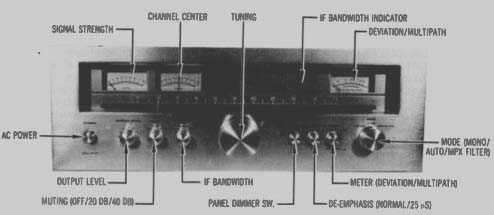
Preparation supervised by Robert Long and Harold A. Rodgers
Laboratory data (unless otherwise noted) supplied by CBS Technology Center
Kenwood's 600-T--a Super-tunable Supertuner
The Equipment: Kenwood 600-1, a stereo FM tuner in metal cabinet.
Dimensions: 17 1/4 by 6 inches (front panel); 15 inches deep plus clearance for controls and connections. Price: $650. Warranty: "limited," two years parts and labor. Manufacturer: Trio Electronics, Japan; U.S. distributor: Kenwood Electronics, Inc., 15777 S. Broadway, Gardena, Calif. 90248.
Comment: The word "super-tunable" in our headline refers to the 600-r s front-panel switch labeled IF BANDWIDTH and its three positions: NARROW, NORMAL and WIDE. Ken wood's engineers have decided to attack one of the fundamental problems in FM tuner design: the fact that selectivity and low distortion are mutually antagonistic. If one is improved, the other is degraded. Why this is so is explained for the technically inclined reader in the box that appears with this report; for the home user, the reasons are less important and the practical effect fairly easy to evaluate.
NORMAL represents the best compromise between selectivity and distortion, and is the best place to leave the switch if you just don't want to be bothered; NARROW is the setting to use for fishing one station out of a crowd (if you can stand a tiny bit more distortion); WIDE will give the best sound of which the tuner is capable--if you're tuned to a fairly strong station that dominates its section of the dial.
The measurements made at the CBS Technology Center concentrated on the NORMAL setting. Suppression of noise by 50 dB in mono is achieved with a mere 12 1/2 dBf of input signal. At slightly above that level noise alone becomes the limiting factor; distortion is so small as to be swamped. A 19 1/2 -dBf signal causes the 600-1 to switch automatically to stereo, and that, for us, is a little too soon. Fortunately, at 34 dBf, still a very modest level of input signal, noise in stereo is suppressed by 50 dB. At levels of 55 dBf and above, the stereo signal-to-noise ratio is in the neighbor hood of 67 to 69 dB. Even when distortion is taken into ac count the total quieting is well in excess of 60 dB, so that in most cases the quality of the broadcast itself will be the ultimate limitation. Separation-just about the best we've seen in a tuner-is far beyond that which the FCC demands of broadcasters.
----------------
REPORT POLICY Equipment reports are based on laboratory measurements and controlled listening tests Unless otherwise noted, test data and measurements are obtained by CBS Technology Center. Stamford. Connecticut, a division of Columbia Broad casting System. Inc . one of the nation's leading research organizations The choice of equipment to be tested rests with me editors of Mom Firtzury. Manufacturers are not permitted to read reports in advance of publication. and no report, or portion thereof, may be reproduced tor any purpose or in any form without written permission of the publisher All reports should be Construed as applying to the specific samples tested, neither Hi-Fi CBS Technology Center assumes responsibility for product Performance or quality.
----------------
Kenwood has provided the 600-T with a generous assortment of front-panel indicators. In addition to the usual signal-strength and channel-center meters (the latter has unusually good resolution), there is a meter that reads percentage of modulation. At the touch of a button, this same meter indicates multipath. Instrumentation such as this makes the scope outputs provided on the back seem al most redundant.
Beyond the measurable effects of the IF BANDWIDTH switch in reducing distortion and improving capture ratio ever so slightly when set to the WIDE position, this control makes a difference that is subtle but definitely audible.
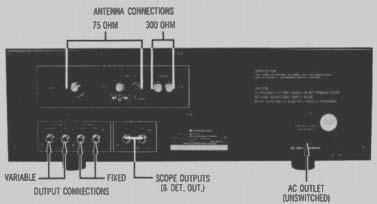
With the wide bandwidth, the Kenwood delivers a listening quality that we judge superior to that of a tuner costing ...
-------------------------
Tuner Bandwidth and Distortion: What's the Story?
Soon after a radio-frequency signal appears at the in put of an FM tuner, a circuit known as a converter shifts this RF so that it’s centered at 10.7 MHz, the intermediate frequency-not the original, tuned frequency, and not yet audio. It’s in this form (dubbed IF) that most of the signal amplification inside the tuner takes place.
It may seem that since the frequency deviation of t- 75 kHz is the normal maximum used in FM (stations sometimes over-modulate briefly), an IF bandwidth of 150 kHz is all that is necessary to recover the carrier.
Mathematical analysis shows that this is not so and that in theory side bands exist at frequencies infinitely remote from the nominal carrier frequency.
Fortunately, the side-band energy falls off rapidly enough that practical IF bandwidths give very fine performance with adequately low distortion.
But there is another problem: It has been shown that, when the high-order side bands (those near the edges of the IF bandpass) are shifted in phase with respect to the carrier, distortion is increased. Filters that cut off sharply characteristically cause more phase shift at the edges of their bandpass than toward the center. So while a sharp IF cutoff is necessary to prevent interference from stations near the one to which the apparatus is tuned, it inevitably in creases distortion. Hence the inherent tradeoff in all FM tuners: selectivity vs. distortion.
----------------
... $100 more. Using the narrow IF, it’s not quite the sonic equal of this reference tuner in devoting exclusive attention to one of a group of closely spaced stations, but with the 83 dB alternate-channel selectivity attained in this mode, it comes awfully close. In being as selective as all that, the NARROW position squeezes the signal a tiny bit out of shape and elicits protests in the form of slightly in creased distortion (which is extremely low to begin with), with the greatest added distortion at very high signal strengths. It never becomes really serious, but the effect is sufficient, we think, to prompt an attentive listener to prefer the NORMAL and WIDE settings whenever they can be used successfully.
Looked at in toto the Kenwood 600-T is a true super tuner. Its performance alone justifies inclusion in the class, and its instrumentation and control features are un usually comprehensive-even in such exalted company.
While an experienced hand helps to get the best out of these controls, it’s by no means required. And if you feel that, having paid a good deal of cash, you're entitled to keep your fingers unsullied by anything but the tuning knob (which is conveniently placed, even for southpaws), set the IF to NORMAL and relax. You won't get the very best the machine can deliver, but what you do get will be awfully good.
-----------
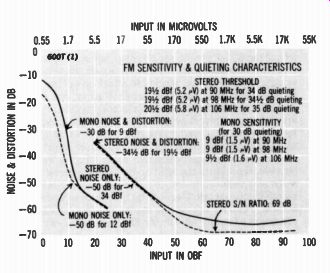
INPUT IN MICROVOLTS ; FM SENSITIVITY & QUIETING CHARACTERISTICS
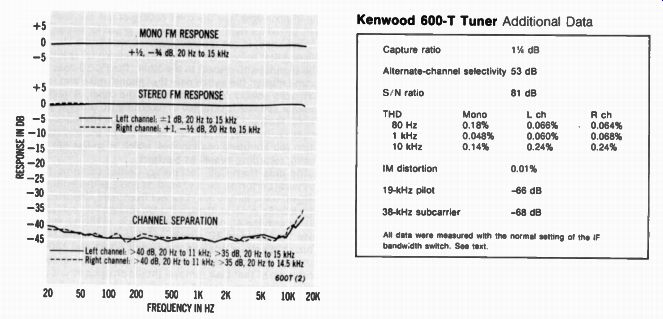
----------- MONO FM RESPONSE; Kenwood 600-T Tuner Additional
Data
+++++++++++++++
Teac's Entry in the Road/Home Deck Sweepstakes
The Equipment: Teac Esoteric Series Model PC-10, a battery. AC portable cassette deck, in metal case with detach able shoulder strap. Dimensions: 11 1/2 inches wide (plus allowance for connections and strap-attachment studs), 3 3/4 inches high, 9 1/4 inches deep (plus allowance for controls). Price: under $500 (including Model PA-2 AC adapter). Warranty: "limited," two years parts and labor, shipping paid one way. Manufacturer: Teac Corp., Japan; U.S. distributor: Teac Corp. of America, 7733 Telegraph Rd., Montebello, Calif. 90640.
Comment: It’s sad but true that relatively few Americans have yet discovered the joys of "sound collecting" (as the PC-10's manual calls it) with a portable recorder-preferably a high-quality cassette deck like this one. The Japanese, who are not nearly so shy about documenting aural events, have created the genre and the equipment for it: battery portables good enough to be used as home decks as well. When other companies have brought such decks into this country, reader interest has run high (surprisingly high, considering how little sound collecting seems to be done here), and now it's Teac's turn.
The PC-10 is no-nonsense in appearance, sturdy in construction, and (at a hair over 9 1/2 pounds without the six D cells) only moderately hefty for this class. Its transport controls (which follow the scheme of the A-400, on which we reported in May 1976) are unconventional and, at first glance, may seem relatively difficult to operate with the deck slung over one shoulder. On the contrary, we find that with a little practice you can get it even into the recording mode with one hand and practically no fuss. The fast wind lever's central position is a STOP--as is the left-hand position of the upper lever, for normal transport speed; these two are interlocked so that one must be in the STOP position if the other is to be activated. In one fast-wind mode the lever can easily and unintentionally be pushed right through STOP to the other extreme when, say, you're hurriedly trying to rescue the tape--a minor (but material) inconvenience, at least for one-hand on-location work.
The PC-10 has no ON/OFF switch; engaging the trans port controls automatically turns on the electronics. There is a recording pilot next to the REC button. Presumably to minimize battery drain, Teac has used no light here (simply a window through which a red flag shows when the but ton is pressed in), which makes it a bit hard to spot, de pending on ambient light. The travel of the REC button is great enough, however, that you can check it-by eye or by touch. The light in the meters is normally out. In battery operation you can illuminate the meters momentarily by pressing the LIGHT button; in AC operation (or when meter visibility is more critical than battery drain) you can turn this button clockwise with a fingertip to lock the light on.
The meters follow Teac's usual scheme: They read aver age values but are equipped with a light-emitting diode to show when instantaneous signal values are in excess of 6 dB above the meters' 0 VU. When the limiter, which is "downstream" of the meters and LED, is switched in, it will lop off any instantaneous signal values above about + 3 VU on the meters (it is not a level-altering AGC) with surprisingly little compromise in sound quality even when driven hard. Since the metering s unaffected by the limiting, you can always tell how hard the limiter is being driven. So while most recordists fill avoid using the limiter, at least for music, this one is particularly efficient and well suited to field use.
Other nice touches, especially for one-hand field recording in poor light, are the color coding of the channel elements (red for right on the outer ring, green for left on the central knob) in the recording level control and a stud on the ring that helps override the friction clutch for resetting one channel with respect to the other. The PC-10 does not permit mixing; the switch near the (phone) mike and (pin) line jacks selects one input pair or the other. A built-in monitor speaker is disabled in recording (to prevent accidental feedback) and reproduces the tape (in mono) on playback. Its level control can be turned all the way down when you are using headphones, which of course are live during recording as well as playback.
The data from CBS Technology Center confirms that technical performance is at least as good as the externals suggest-and as one might expect from Teac. Distortion is very low. So is noise, though the lab made all its measurements with the AC power supply. (This is, in theory, worst case because any AC supply will introduce some hum. Though spectrum analysis shows that 60-Hz and 180-Hz hum are present, they are less than in typical home decks and so small that their removal should produce little if any measurable improvement in weighted S/N ratios.) Motion al stability also is excellent--thanks, presumably, to the DC servo drive that makes the transport speed independent of supply voltage (at least within the acceptable range ...
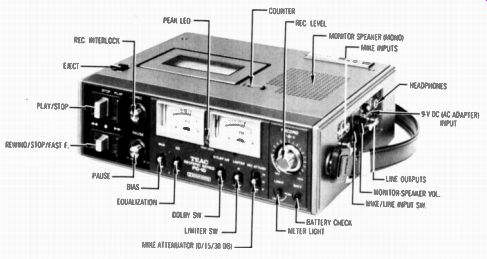
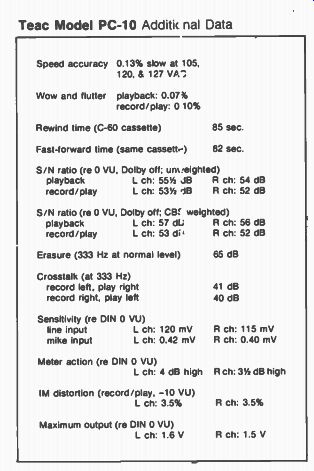
----------- Teac Model PC-10 Additional Data; DIN PLAYBACK RESPONSE
...shown on the battery-check metering) and the transport stability free of the inertial effects introduced (when a portable is moved about) by the flywheels of garden-variety drive systems.
The tapes used to test the PC-10 were Maxell UDXL-I ferric and Fuji chrome. Frequency response is excellent with chrome tapes despite a slight rise in the midbass. Response is similar, though not quite as extended on the high end, with ferric tape. When the Dolby circuit is switched in, it shaves a bit off the treble, making the numerical performance characterization appear poorer, though the actual difference is slight.
Teac's switching (again, like that of the A-400) offers two options for bias and a similar pair for equalization. On both switches the "1" position is appropriate for chromium dioxide (or chrome-compatible ferri-cobalts like SA or UDXL-II), the "2" position for ferrics-preferably, on the basis of the lab data, the "energetic" types like UDXL I, but the manual lists a number of more mundane formulations that would be appropriate for saving money at the expense of some high-frequency performance. For fern chromes (Duad and Classic) Teac suggests the ferric bias position and the chrome equalization.
We find that personal feelings about what makes for an ideal battery-portable recorder run high and vary widely from one recordist to the next, so it would be foolhardy to make any across-the-board recommendation among the decks available for this purpose. It seems to us, however, that whatever an individual recordist's predilections, the PC-10 has to be among the major contenders for his admiration. The monitor speaker, while obviously not a paragon of audio, is a distinct asset in the field; the switching and other controls are exceptionally well thought-out in many respects; insofar as we can judge it, the unit seems unusually durable; performance is excellent.
+++++++++++++++++
Pickering's Stereohedron New Shape for Stereo
The Equipment: Pickering XSV-3000, a stereo phono cartridge with Stereohedron diamond stylus. Price: $99.95.
Warranty: "full," one year parts and labor. Manufacturer: Pickering & Co., Inc., 101 Sunnyside Blvd., Plainview, N.Y. 11803.
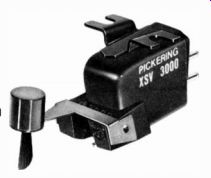
Comment: Whatever the fate of CD-4 in the audio market place is to be, it must be credited with bringing about improvements in the design of phono pickups. To achieve the wide bandwidth necessary for proper carrier reproduction, while maintaining stylus bearing pressures low enough to avoid scrubbing away the carrier, is in itself no mean feat, and to maintain accurate performance in the baseband region (that used for two-channel stereo) at the same time is harder still. The designers at Pickering accomplished these aims in the XUV-4500Q (their top model, intended for optimum performance with all discs including CD-4) and in the process became convinced that the special Quadrahedral stylus shape developed for the XUV per formed better than an elliptical with two-channel material.
Since the Quadrahedral stylus assembly is costly and rep resents an overdesign for stereo (including matrixed quad), some simplifications could be made. The result is the Stereohedron stylus, which is making its first appearance in the XSV-3000 pickup.
In the testing at the CBS Technology Center, the new cartridge presented some surprises, first by managing the required obstacle course with a vertical tracking force of just 0.4 gram. This is slightly less than that required by the XUV-4500Q, despite the fact that the recommended range of VTF is higher for the XSV-3000. (The balance of the tests were, however, carried out at 1 1/8 grams VTF, the center of Pickering's recommended range.) The pickup is also somewhat more sensitive than its precursor and generally produces less harmonic distortion. Tested for maximum tracking levels, it gives data identical to those for the XUV 4500Q. The frequency response is flat within ± 1 dB up to 7 kHz, where it begins to rise into a familiar-looking high-end peak that is somewhat less prominent than that of the XUV-4500Q. Separation is 20 dB or better from 20 Hz to 20 kHz, reaching close to 35 dB at mid band. IM distortion is slightly higher than that of the CD-4 cartridge, but still very low.
A 1-kHz square wave is reproduced very well by this pickup. The scope trace shows very slight overshoot with ringing (all ultrasonic) controlled unusually well. The low frequency resonance, tested in a 12-inch SME arm, is be tween 7 and 8 Hz, indicating that, for best tracking of warped discs, the cartridge would prefer a less massive arm. The stylus tip has good geometry and alignment.
The sound of the XSV-3000 is, as one might expect, very similar to that of the XUV-4500Q, which is to say that it’s very fine indeed. Instrumental timbres are well defined without becoming brittle, and there is a good stereo perspective with a nice sense of depth. Also, the relatively high output-measuring 1.24 millivolts per centimeter per second at 1 kHz in the right channel and 1/4 dB less in the left-allows the user to keep gain lower, thereby improving attainable signal-to-noise ratio.
Pickering, as is customary for that company, has equipped the cartridge with a brush that rides ahead of the stylus to clean the groove. Proper tracking thus requires that an extra gram of VTF be added to compensate for the force exerted by the brush. We have found, however, that removal of the brush is sometimes advantageous (for the small reduction in mass, if nothing else) when it becomes necessary to play badly warped discs.
In all, we feel that Pickering has done very well in introducing the XSV-3000. The new unit offers the stereo performance of the XUV-4500Q (or perhaps a little better than that) at a lower price. It seems hard to go wrong with such a combination.
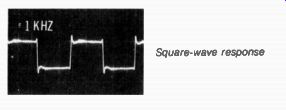
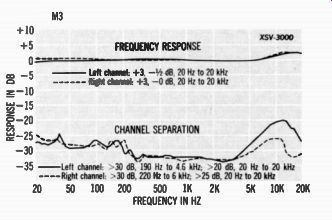
-------- Square-wave response ; FREQUENCY RESPONSE
+++++++++++++++++++++
Garrard's Second-Generation Tangent-Tracking Automatic
The Equipment: Garrard GT-55, a two-speed (33, 45 rpm) automatic record changer with tangent-tracking tone arm and optional base and dust cover. Dimensions: 17 by 15 1/2 inches (top of base), 8 1/2 inches high with dust cover closed, 183 / 4 inches clearance required with dust cover fully open. Price: chassis, $249.95; base, $15.95; dust cover, $9.95; deluxe base (includes dust cover), $39.95.
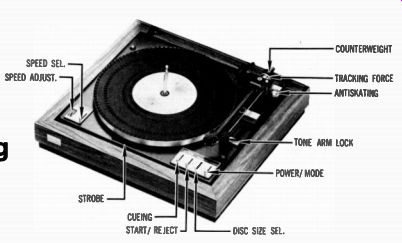
Warranty: "limited," one year parts and labor. Manufacturer: Garrard Engineering, Ltd., England; U.S. distributor: Plessey Consumer Products, 100 Commercial St., Plain view, N.Y. 11803.
Comment: When first introduced in the Zero 100, Garrard's pivoted tangent-tracking tone arm constituted a breakthrough in accurate record-playing. At that time the tracking error measured by CBS labs was ± 0.25 degree, and HIGH FIDELITY review called the new device "probably the best arm yet offered as an integral part of an automatic player." But the arm had its drawbacks: It was fairly massive, and the multiplicity of pivots needed to maintain the tangent geometry resulted in relatively high friction, especially in the horizontal plane. The arm offered in the GT-55 has solved both of these problems neatly. Measured friction is now negligible in both planes, and a good deal of clever engineering has gone into reducing effective mass to a small figure-with a cartridge and counterweight in place.
Replacing the synchronous motor and rim drive of the Zero 100 is a new DC servo-controlled motor and belt drive. Speed change is now accomplished electrically rather than mechanically, which should result in greater long-term reliability. Like its predecessor, the GT-55 maintains exactly speeds that are set at 120 VAC supply voltage when the voltage is changed to 105 and 127. The range of speed control exceeds the manufacturer's spec (about a quarter tone in either direction) by a handy margin, and flutter, measured with ANSI/IEEE weighting, is 0.04%, well into the inaudible range. Total audible rumble measures -56 dB, using the ARLL weighting developed by CBS--better than acceptable in an automatic player.
Numerical documentation of the reduction in tone-arm mass is provided by the 7-Hz resonance measured with the Shure V-15 Type III cartridge. (The Zero 100 arm had a 6.5 Hz resonance with a less compliant cartridge.) In the present arm, the resonance is exceedingly well damped, showing a mere 1 1/2 -dB rise. Automatic tripping is accomplished with a stylus force of 0.2 gram, below the range where even feather-touch fanatics attempt to track. The indicators for stylus force and antiskating force are right on the money, and a Garrard spokesman informs us that the antiskating is designed to adjust automatically for the change in angle as the arm moves across the disc. The rate at which the damped cueing control operates is adjustable from fast to slow. Slow is very slow indeed (4 seconds or more from release of CUE to contact of the stylus with the disc) and can lead one to suspect that the unit has cycled off with the arm stuck up in the air, when such is actually not the case. The action is gentle in all cases.
Gentle also describes the way in which the GT-55 changes records. The fact that the controls are mechanically part of the system that supports the platter means that they must be worked with a very light touch if the tracking of the tone arm is not to be upset. Likewise, care must be used when adding a record to the stack while another is playing. Other than that, the player is quite simple to operate. It can be used manually, manually with automatic start and stop, automatically as a changer, or in its REPEAT mode (which will play a side over and over until you push REJECT). The entire change cycle takes 12 seconds. A set of accessories is provided, including a short single-play spindle, a long spindle for multiple play, a single-play adapter for 45-rpm discs, and an overhang gauge.
In sum, we find the GT-55 a worthy successor to the Zero 100. Nowhere does it fall short of good mechanical performance, and its inherent flutter is about the lowest we have ever measured in a changer. As was the case with its predecessor, its particular strength is its tone arm, which provides accurate tangent tracking at a down-to-earth price. It looks as if Garrard has done it again.
++++++++++++++++++
Akai's Deck Is Stacked In Your Favor
The Equipment: Akai GXC-570D, a front-loading stereo cassette deck, in wood case with vinyl finish.
Dimensions: 9 1/2 by 17 1/2 inches (front panel); 8 inches deep plus clearance for controls and connections. Price- $875. Warranty: "limited," one year parts and labor. Manufacturer: Akai Electric Co., Ltd., Japan; U.S. distributor: Akai America, Ltd., 2139 Del Amo Blvd. Compton, Calif. 90220.
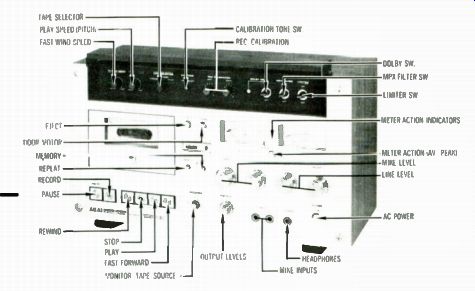
Comment: Cassette decks with three heads are not your common, everyday components, and the reason is not at all obscure. Simply, the opening at the front of a compact cassette gets a mite crowded when it has to accommodate the extra head. But the problem can be solved-and, as the Akai GXC-570D proves, in first-rate style. Few pains have been spared to stack the deck with just about any feature a recordist might want.
As inveterate readers of these pages know, we have ex pressed reservations about front loading because of the extra complications that often attend it. The 570D's "well" is, however, on a par with many top loaders in this respect. I lead cleaning is not particularly easy despite a re movable door panel, but it’s not particularly hard either.
Under the transparent plastic door that extends across the top of the deck are the less often used controls. So that you can impress your friends (says Akai), or possibly to keep fingerprints off the plastic, the door is opened and closed by a motor controlled by a front-panel button-but working it manually does no harm.
The transport controls are a set of capacitance switches (which barely need finger proximity-much less a positive push), triggering solenoids. This gives the deck an elegant operational feel quite unlike that of most competing units.
Each of the buttons (except STOP) has a lighting indicator to show when it’s engaged. There is an interlock-via a "logic" system-so that you can go directly from a fast wind mode to PLAY, but the deck will pause for an instant before the drive actually engages, to prevent tape damage.
The only way we could find to confound the logic was to press the EJECT button during fast wind (which we don't recommend, even to impress your friends). In one of a number of tries we snarled a tape. Using the slowest wind speed might have prevented this, but as the lab data show, the wind speed is fairly zippy at any setting of the control.
This control scheme does impose on the user some operating habits that might not otherwise be required. First, the sensitivity of the switches makes it easy to trigger FAST WIND when you reach for the MONITOR switch. (We learned this the hard way-by ruining a few recordings.) Second, the solenoid operation is so quick that the PAUSE offers no particular advantage in stop-go operations; moreover, the PAUSE leaves an audible click on the tape during recording, which the STOP and RECORD/PLAY do not. Since incoming signals can be metered by setting the MONITOR switch to SOURCE without setting the deck to record, we suggest that users simply ignore the PAUSE for most purposes.
The MONITOR switch (used with care) is one of the things that makes recording with this Akai deck such a delight.
You always know exactly what is going onto the tape and how it sounds coming back off. A headphone output is pro vided (with a moderate, nonadjustable drive level) so that you can retain this capability while recording live. The meters are large and have scales that extend to -40 dB. They are also switchable to either peak-reading mode or normal VU (averaging) characteristics. Measurements made at CBS labs show that the calibration is such that DIN 0-VU level reads out as -2 dB in peak mode and + 6 dB (beyond the meters' calibration range) in VU mode, an arrangement that strikes us as very sensible, since in the faster mode the extra 8 dB of headroom can easily be dispensed with. The meters track each other just about perfectly in either mode, as do the stepped recording controls.
LINE and mic inputs (back-panel pin jacks and front panel phone jacks, respectively) have separate pots for each channel and can be mixed. A single knob controls the output level for both channels and does not affect meter readings. The limiter does what it should, but we feel that it would be a shame to use it as anything but a method of last resort. With a signal-to-noise ratio exceeding 60 dB (with Dolby), the 570D has sufficient dynamic range for most recordings; but the limiter should be useful for recordings (of live-music events, For example) in which peak levels can't be predicted, where (as in conference recordings) levels are all over the lot, or in situations that require the recordist to be occupied elsewhere instead of manning the controls. For this last situation, the optional RC-18 remote-control unit ($50, not tested), which plugs into the back panel, may be particularly handy.
The tapes with which the lab tested the 570D (at Akai's suggestion) were Fuji FL (its lower-priced ferric formulation) in the LOW-NOISE position, BASF Chromdioxid in CHROME, and Sony Duad ferrichrome in FECR. Of course the accessible REC CALIBRATION controls, plus the monitoring head, make this deck unusually easy to readjust for other tapes that differ from these three only in sensitivity; we were able to get excellent results with a number of alternate tapes And, as the graphs show, response is uncommonly extended on the high end (if a little peaky in some curves at the extreme top), very flat throughout the midband, and rolls off just a bit in the bass. Playback response from the DIN test tape is unusually flat throughout the range. Distortion figures are fairly typical of current cassette equipment of good quality with midband harmonic distortion commendably low.
Speed figures are shown with the PITCH control adjusted for correct speed at 120 volts. With this control (which has an adjustment range of about 4%) set at its central click stop, the deck measures 0.6% fast. Comparison of this figure with those for measurements made at other line volt.
ages suggests that Akai has designed for correct speed at the click-stop and a line voltage somewhere between 105 and 120 VAC (the condition one encounters most often in typical home conditions) with only negligible variation as line voltage changes within accepted limits. This plus the excellent wow and flutter figures add up to fine motional stability.
The Akai GXC-570D strikes us as a most appealing cassette deck, suitable for live recording as well as the more mundane work of dubbing treasured discs or preserving ephemera from FM. In most respects it’s convenient to operate and performs at a high level close to the state of the art. Cheap it’s not. but then decks so stacked (with features) do have a way of costing money. There's no card sharp here, so the deal works in your favor.
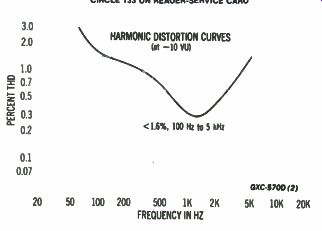
-------- HARMONIC DISTORTION CURVES
DIN PLAYBACK RESPONSE
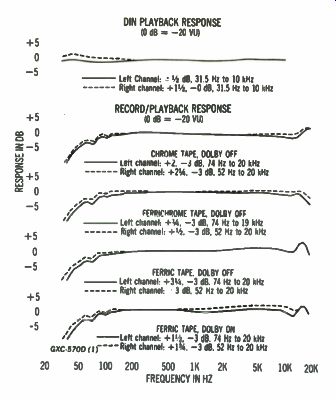
----- Akai GXC-570D Additional Data
-------------
(High Fidelity, Feb 1977)
Also see:
What Cassette Tests Don't Tell You